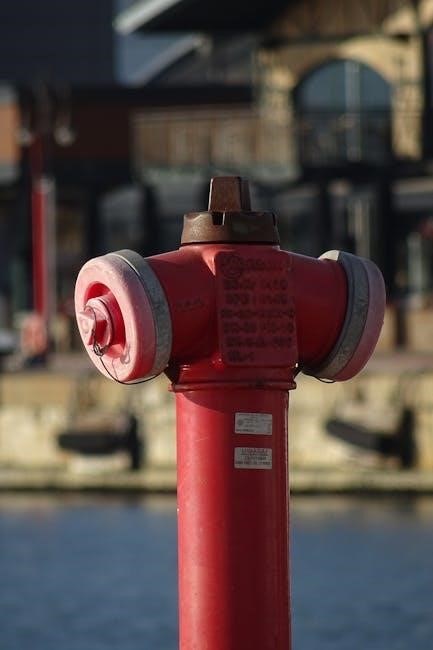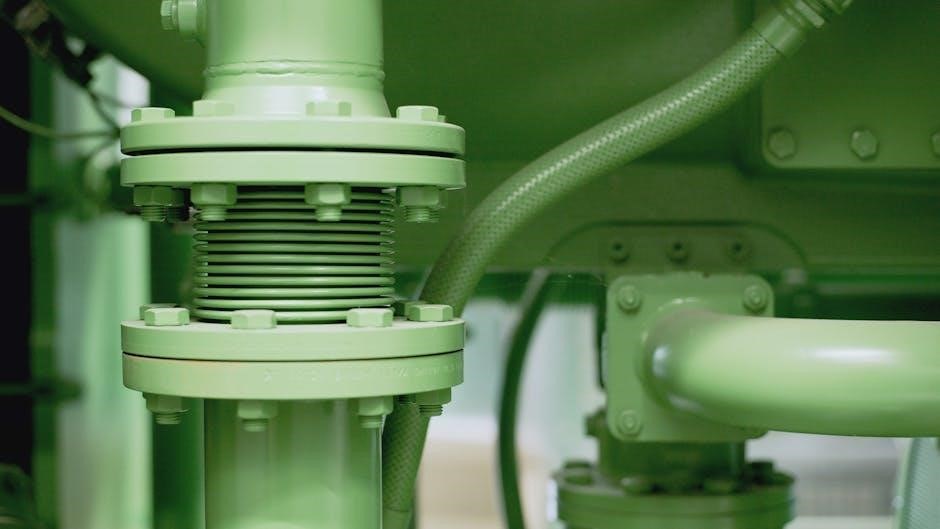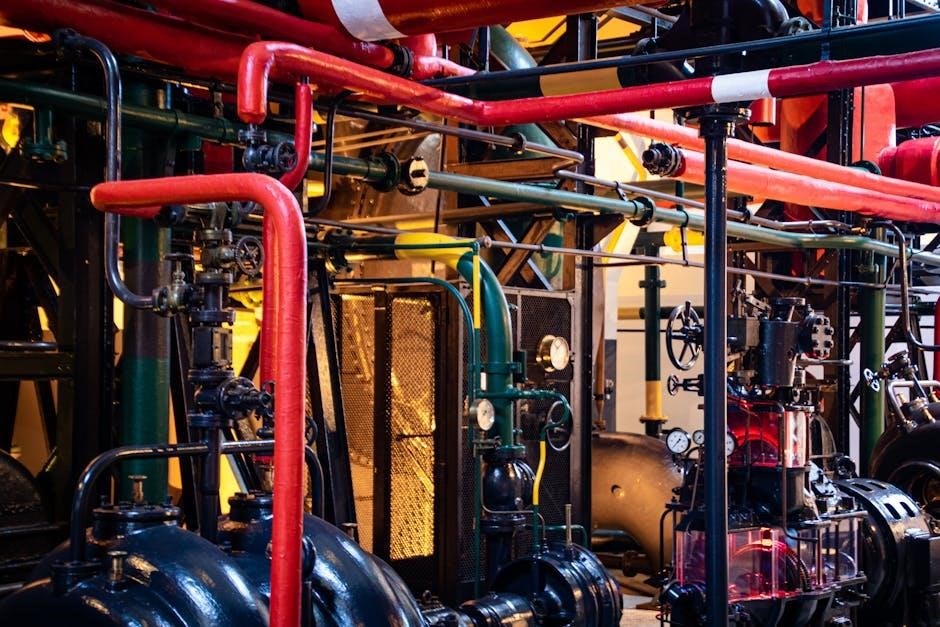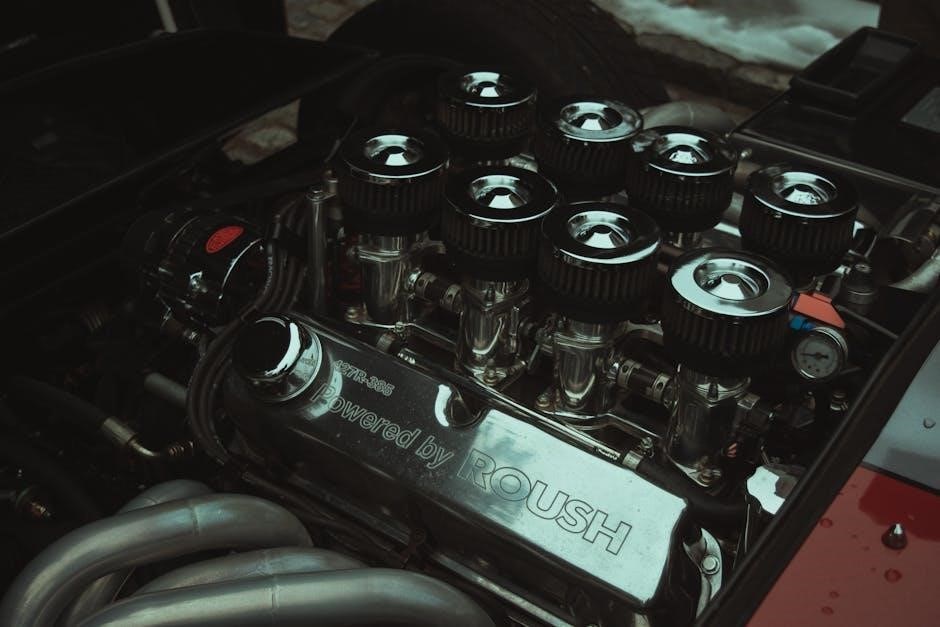The Autococker valve guide is a critical component designed to enhance the performance and reliability of paintball markers. It ensures proper airflow and reduces wear on internal parts, making it essential for maintaining operational consistency and improving overall efficiency.
1.1 Overview
The Autococker valve guide is a vital component designed to optimize the performance of paintball markers, particularly the Autococker series. It plays a crucial role in ensuring smooth airflow and reducing wear on internal parts, which directly impacts the marker’s reliability and efficiency; The valve guide is engineered to fit seamlessly within the marker’s mechanism, providing a consistent and controlled airflow path. This design helps maintain optimal pressure and velocity, ensuring accurate and consistent shots. The guide’s structure typically includes features such as precision-machined surfaces and strategic porting to enhance performance. Its primary function is to stabilize the valve operation, minimizing the risk of inconsistent firing or damage to the valve itself. Over time, the Autococker valve guide has become a standard upgrade for players seeking to improve their marker’s functionality. It is widely regarded as a key component for maintaining peak performance and extending the lifespan of the Autococker system.
1.2 Historical Context
The Autococker valve guide traces its origins to the early days of paintball, emerging as a solution to enhance the performance of the iconic Autococker marker. Introduced in the early 1990s, the Autococker quickly gained popularity among players for its reliability and customization options. However, as the sport evolved, players began to identify areas for improvement, particularly in airflow efficiency and maintenance. The original valve design, while effective, often struggled with inconsistent airflow and wear over time, prompting the development of aftermarket solutions. The valve guide became a critical upgrade, addressing these issues by stabilizing valve operation and improving airflow. Over the years, the design has been refined, with modern versions incorporating advanced materials and engineering to meet the demands of competitive play. This historical evolution underscores the importance of the valve guide in maintaining the Autococker’s reputation as a high-performance marker.

The new valve represents a modern upgrade designed to address the limitations of traditional designs. It offers improved airflow, reduced weight, and enhanced durability, making it a superior choice for contemporary paintball markers.
2.1 Overview
The new valve is a cutting-edge innovation designed to optimize performance in modern paintball markers. It offers a sleeker design, improved airflow, and reduced weight compared to traditional valves. This upgrade ensures smoother operation, higher efficiency, and better reliability. The new valve is crafted with advanced materials, making it more durable and resistant to wear and tear. Its design focuses on minimizing maintenance while maximizing output, ensuring consistent performance under various conditions. Players and enthusiasts can expect enhanced accuracy, faster cycling, and a quieter shot signature; The new valve is also compatible with a wide range of paintball markers, making it a versatile choice for both recreational and competitive play. By addressing the limitations of older models, the new valve sets a higher standard for paintball technology, catering to the evolving needs of the sport. Its innovative features make it a standout option for those seeking superior performance and reliability in their equipment.
2.2 Historical Context
The development of the new valve traces back to advancements in paintball technology over the past decade. Initially, traditional valves like the Autococker valve guide were the standard, known for their reliability but often criticized for their weight and complexity. As the sport evolved, players demanded more efficient and lightweight components. Manufacturers responded by investing in research and development, leading to the creation of the new valve. Drawing inspiration from earlier models, the new valve incorporates lessons learned from years of player feedback and competitive play. It represents a leap forward in design philosophy, focusing on simplicity, durability, and performance. The new valve’s historical context is marked by continuous innovation, aiming to meet the growing expectations of modern paintball enthusiasts. This evolution reflects the broader trend towards more refined and user-friendly equipment in the sport, ensuring that players have access to cutting-edge tools that enhance their gameplay experience.

Key Features
The Autococker valve guide ensures precise airflow control and durability, while the new valve offers enhanced efficiency and a lightweight design. Both focus on improving performance, but the new valve introduces modern advancements for smoother operation.
3.1 Autococker Valve Guide Features
The Autococker valve guide is engineered to optimize airflow efficiency and reduce internal wear. Its robust design ensures consistent performance, making it a reliable choice for maintaining the marker’s operational integrity. The guide’s precision engineering minimizes air leakage, ensuring every shot is consistent and powerful. Additionally, it is compatible with a wide range of setups, offering versatility for different playing styles. The valve guide’s durability reduces maintenance needs, making it a favorite among experienced players. Its straightforward installation and compatibility with existing components make it a practical upgrade for those seeking enhanced performance without major modifications. Overall, the Autococker valve guide delivers a balance of reliability, performance, and durability, solidifying its reputation as a high-quality component in the paintball community.
3.2 New Valve Features
The new valve introduces advanced features designed to enhance performance and adaptability. Its lightweight construction reduces overall marker weight while maintaining durability. The valve boasts improved airflow dynamics, allowing for consistent and efficient gas usage. One standout feature is its compatibility with lower operating pressures, making it ideal for modern markers that prioritize efficiency. The new valve also includes an adjustable speed control, enabling users to fine-tune their settings for optimal performance. Additionally, it features a streamlined design that minimizes air leakage and ensures reliable operation. The valve is also designed to work seamlessly with stock solenoid manifolds, eliminating the need for additional upgrades. Furthermore, it incorporates a user-friendly interface for easy maintenance and customization. These innovations make the new valve a versatile and high-performing option for players seeking precision and reliability in their equipment.

Performance
The Autococker valve guide delivers reliable performance, ensuring consistent airflow and reducing internal wear. The new valve excels in efficiency, offering enhanced gas usage and faster response times, making it ideal for competitive play.
4.1 Autococker Valve Guide Performance
The Autococker valve guide is renowned for its consistent and reliable performance, ensuring smooth operation of the paintball marker. By guiding the valve precisely, it minimizes wear and tear on internal components, which helps maintain optimal functionality. Players often praise its ability to deliver steady airflow, resulting in consistent shot accuracy and velocity. The design of the valve guide contributes to reduced friction, which in turn lowers the risk of mechanical failure during intense gameplay. Furthermore, the Autococker valve guide is known for its durability, with many users reporting extended marker lifespans due to its robust construction. These features make it a popular choice among both casual and competitive players seeking dependable performance. Overall, the Autococker valve guide stands out as a reliable component that enhances the overall efficiency and longevity of the marker.
4.2 New Valve Performance
The new valve demonstrates exceptional performance, offering enhanced efficiency and reliability compared to traditional designs. It is engineered to handle lower operating pressures, which allows for smoother airflow and consistent shot velocity. Users have reported improved accuracy and reduced sound signature, making it ideal for competitive play. The new valve’s ability to accommodate higher airflow demands ensures optimal performance, even in high-speed gaming scenarios. Its design incorporates advanced materials and precision engineering, leading to increased durability and resistance to wear. Additionally, the new valve minimizes maintenance needs while delivering a more responsive trigger pull. Overall, the new valve represents a significant advancement in paintball technology, providing players with a reliable and high-performance option that meets the demands of modern gameplay.

Maintenance
Maintaining both the Autococker valve guide and the new valve is essential for optimal performance. Regular cleaning and o-ring replacements are crucial for the valve guide, while the new valve requires less frequent servicing but still needs attention to ensure proper function and longevity over time.

5.1 Autococker Valve Guide Maintenance
Maintaining the Autococker valve guide is crucial for ensuring optimal performance and longevity. Regular cleaning is essential to remove dirt and debris that can accumulate and affect airflow. Users should inspect the guide for wear and tear, as excessive wear can lead to leaks or inconsistent operation. Lubrication of the valve stem and surrounding components is recommended to reduce friction and prevent corrosion. Additionally, o-rings should be replaced periodically to maintain a tight seal. It is important to avoid using harsh chemicals, as they can damage the materials. Proper installation and alignment of the valve guide are also vital to prevent damage during reassembly. For those unfamiliar with the process, consulting a professional or following detailed tutorials can help ensure maintenance is done correctly. Regular maintenance not only preserves the functionality of the valve guide but also enhances the overall efficiency of the paintball marker.
5.2 New Valve Maintenance
Maintaining the new valve requires attention to detail to ensure optimal functionality. Regular inspection of the valve stem and surrounding components is crucial to identify any signs of wear or damage. Lubrication is essential, but it is important to use the correct type of lubricant to avoid compromising the valve’s performance. Unlike the Autococker valve guide, the new valve often benefits from adjusting the operating pressure to match the specific needs of the paintball marker. Users should also check for proper installation, as misalignment can lead to inefficiencies or leaks. Cleaning the valve periodically with a soft cloth and mild solvent can prevent debris buildup; Additionally, upgrading to a modern solenoid manifold can enhance the valve’s performance. It is advisable to follow the manufacturer’s guidelines for maintenance to ensure longevity. Regular maintenance not only preserves the valve’s functionality but also contributes to the overall reliability and efficiency of the paintball marker.

Cost and Value
Evaluating cost and value involves comparing prices and assessing long-term benefits. The Autococker valve guide and new valve differ in pricing, with the new valve often being more expensive due to advanced features and improved efficiency, offering better value for serious players seeking optimal performance and durability.
6.1 Price Comparison
The Autococker valve guide is generally priced between $40 to $70, making it an affordable option for most paintball enthusiasts. In contrast, the new valve typically ranges from $80 to $120, reflecting its advanced design and materials. While the new valve is more expensive upfront, its improved efficiency and durability often justify the higher cost for serious players. The price difference is primarily due to the new valve’s enhanced engineering, which incorporates superior materials and precision manufacturing. For casual users, the Autococker valve guide remains a cost-effective choice. However, for professionals seeking optimal performance, the new valve’s premium pricing aligns with its superior functionality and longevity; This comparison highlights the balance between affordability and advanced technology, catering to different user needs and budgets in the paintball community.
6.2 Value Analysis
The value of the Autococker valve guide and the new valve depends on the user’s specific needs and preferences. For casual players or those on a budget, the Autococker valve guide offers excellent value, providing reliable performance at a lower cost. It is a practical choice for maintaining consistent airflow and reducing wear on internal components, making it a cost-effective solution for everyday use.
In contrast, the new valve, while more expensive, delivers superior efficiency and durability, making it a worthwhile investment for serious players or professionals. Its advanced design and materials result in lower maintenance costs over time, as it requires less frequent replacements and adjustments. Additionally, the new valve’s improved performance can enhance overall gameplay, providing better accuracy and consistency.
Ultimately, the value lies in balancing affordability with performance. The Autococker valve guide is ideal for those prioritizing cost-effectiveness, while the new valve is better suited for those seeking long-term reliability and high-end performance. Both options cater to different user profiles, ensuring a tailored solution for varying needs and budgets.
User Feedback
Users praise both the Autococker valve guide and the new valve for their reliability and performance. Many highlight the Autococker’s cost-effectiveness and ease of installation, while the new valve is lauded for its improved airflow and durability.
7.1 Community Reviews
The paintball community has shared extensive feedback on both the Autococker valve guide and the new valve, providing valuable insights for potential buyers. Many users have praised the Autococker valve guide for its reliability and cost-effectiveness. Players highlight its ease of installation and consistent performance, making it a favorite among those who value simplicity and durability. Some enthusiasts have noted that while it may not offer the latest advancements, it remains a solid choice for maintaining optimal airflow and reducing wear on internal components.
On the other hand, the new valve has garnered attention for its innovative design and improved functionality. Reviewers often mention its smoother operation and reduced noise, which enhances the overall shooting experience. However, a few users have expressed concerns about its higher price point and the complexity of installation compared to the Autococker valve guide. Despite this, many agree that the new valve’s advanced features, such as better airflow control and higher FPS capabilities, make it a worthwhile upgrade for serious players.
Overall, community reviews suggest that both options have their strengths, with the Autococker valve guide appealing to budget-conscious users and the new valve catering to those seeking cutting-edge performance.
7.2 Professional Opinions
Professional painters and technicians have weighed in on the debate between the Autococker valve guide and the new valve, offering insights based on their expertise. Many experts praise the Autococker valve guide for its simplicity and reliability, making it a go-to choice for those seeking a cost-effective solution. They highlight its ease of maintenance and compatibility with a wide range of markers, emphasizing its practicality for casual and competitive players alike.

Regarding the new valve, professionals note its advanced engineering and improved performance metrics. Experts point out its ability to deliver smoother airflow and reduced noise, making it ideal for high-end setups. However, some technicians caution that the new valve’s complexity may require more specialized tools and knowledge for proper installation and maintenance. Despite this, many agree that its enhanced features justify the investment for serious enthusiasts seeking optimal performance.
Anthony Robinson, a seasoned technician, remarked, “The new valve represents a significant leap forward in design, but the Autococker valve guide remains a reliable choice for budget-conscious players.” This sentiment is echoed by many in the professional community, underscoring the importance of choosing the right component based on specific needs and preferences.

Direct Comparison

The Autococker valve guide is renowned for its reliability and cost-effectiveness, while the new valve excels in airflow efficiency and noise reduction. Professionals highlight the new valve’s advanced design but note its higher maintenance complexity compared to the Autococker’s simplicity.
8.1 Side-by-Side Analysis
A direct comparison of the Autococker valve guide and the new valve reveals distinct strengths and weaknesses. The Autococker valve guide is praised for its durability and compatibility with older systems, making it a favorite among vintage paintball enthusiasts. It operates reliably at lower pressures and requires minimal maintenance, appealing to those seeking simplicity. On the other hand, the new valve boasts advanced engineering, offering improved airflow efficiency and a quieter shot signature. Its modern design supports higher performance metrics, such as faster firing rates and reduced air consumption, making it ideal for competitive players. While the new valve excels in innovation, it may require more precise tuning and is less forgiving for DIY modifications. In contrast, the Autococker valve guide remains a practical choice for those prioritizing ease of use and long-term reliability. Both options cater to different user preferences, whether it’s tradition and simplicity or cutting-edge performance.
8.2 Pros and Cons
The Autococker valve guide and the new valve each have their own set of advantages and disadvantages. The Autococker valve guide is known for its reliability and simplicity, making it a durable option for those who prefer traditional setups. It operates well at lower pressures and requires minimal maintenance, which is a significant plus for casual users. However, it may lack the efficiency and innovation of newer designs, potentially limiting its performance in high-demand scenarios.
The new valve, on the other hand, offers improved airflow and a quieter operation, making it ideal for competitive play. Its modern design supports higher firing rates and better air efficiency, appealing to serious players. However, it can be more expensive and may require more precise tuning, which could be a drawback for some. Ultimately, the choice depends on whether prioritizing tradition and simplicity or embracing cutting-edge performance is more important.
The comparison between the Autococker valve guide and the new valve highlights their unique strengths. The Autococker offers simplicity and reliability, while the new valve provides enhanced performance and efficiency. Choose based on your specific needs and preferences for optimal results.
9.1 Final Thoughts
9.2 Future Outlook
The future of the Autococker valve guide and the new valve is poised for exciting developments. As paintball technology evolves, manufacturers are likely to refine both designs further, integrating innovative materials and engineering to enhance performance. The Autococker valve guide may see advancements in durability and compatibility with modern markers, while the new valve could continue to push the boundaries of efficiency and flow rates. Market demand for lightweight, high-performance components will drive these innovations, ensuring both options remain relevant. Additionally, community feedback and competitive dynamics will play a crucial role in shaping their future iterations. As players seek optimal reliability and cutting-edge features, the industry will adapt to meet these needs, ensuring a bright and competitive future for both the Autococker valve guide and the new valve.
